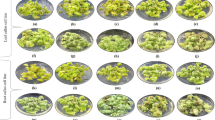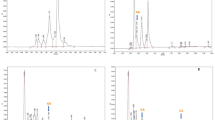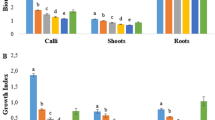Abstract
The rising demand for picrosides commercially and over-exploitation of Picrorhiza kurroa from natural habitat has to initiate alternative strategies for sustainable production of metabolites. In the present research, wild leaf explant of P. kurroa was used to produce friable callus under different culture condition, i.e., dark and light with two temperature variants (15 °C and 25 °C). Afterward, callus cell lines were screened based on growth biomass and metabolites content accumulation. The results revealed, maximum callus growth index along with antioxidant potential (IC50–40.88 μg/mL) and total phenol content (41.35 μg/mg) were observed under dark 25 °C. However, under light 15 °C, highest accumulation of picroside II (0.58 μg/mg), cinnamic acid (0.15 μg/mg), p-hydroxy acetophenone (0.30 μg/mg), total flavonoids (77.30 μg/mg), nitrogen (7.06%), carbohydrates (18.03%), and protein (44.12%) were detected. Major reported metabolite in callus was picroside I (1.63 μg/mg) under dark 15 °C. For the first time, picroside III content (range 0.15–0.56 μg/mg) was also detected and quantified in leaf-derived calli. Expression profiling of picroside biosynthetic pathway genes showed a positive correlation with the observed metabolites. Furthermore, an optimized protocol of metabolites enriched callus biomass could be used as potential strategy for sustainable production of picrosides at commercial scale.






Similar content being viewed by others
Change history
25 July 2022
A Correction to this paper has been published: https://doi.org/10.1007/s12010-021-03638-1
Abbreviations
- AA:
-
Ascorbic acid
- ACT:
-
Anthocyanin 5-aromatic acyltransferase
- AEAC:
-
Ascorbic acid equivalent antioxidant capacity
- ANOVA:
-
Analysis of variance
- ARP:
-
Antiradical power
- CA:
-
Cinnamic acid
- CAF:
-
Caffeic acid
- C4H:
-
Cinnamate-4-hydroxylase
- CAM:
-
Caffeic acid 3-o-methyltransferase
- CM:
-
Chorismate mutase
- CAR:
-
Carbohydrates
- DAHPS:
-
3-Deoxy-D-arabinoheptulosonate 7-phosphate synthase
- DPPH:
-
2,2-Diphenyl-1-picrylhydrazyl
- EC50 :
-
Half maximal effective concentration
- GI:
-
Growth index
- G10H:
-
Geraniol 10-hydroxylase
- GIFW:
-
Growth index fresh weight
- GIDW:
-
Growth index dry weight
- IBA:
-
Indole-3-butyric acid
- IC50 :
-
Half maximal inhibitory concentration
- ISPD:
-
2-C-methyl D-erythritol 4-phosphate cytidylyltransferase
- MDS:
-
Multidimensional scaling
- MS:
-
Murashige and Skoog medium
- N:
-
Nitrogen
- P. kurroa :
-
Picrorhiza kurroa
- P-I:
-
Picroside I
- P-II:
-
Picroside II
- P-III:
-
Picroside III
- PCA:
-
Principal component analysis
- PHA:
-
p-Hydroxy acetophenone
- PMK:
-
Phosphomevalonate kinase
- PPM:
-
Plant preservative mixture
- PR:
-
Protein
- RT-qPCR:
-
Quantitative real-time polymerase chain reaction
- TDZ:
-
Thidiazuron
- TFC:
-
Total flavonoid content
- TPC:
-
Total phenolic content
- UHPLC-PDA:
-
Ultra-high-performance liquid chromatography-photometric diode array
References
Chettri, N., Sharma, E., & Lama, S. D. (2005). Non-timber forest produces utilization, distribution and status in a trekking corridor of Sikkim, India. Lyonia, 8(1), 89–101.
Debnath, P., Rathore, S., Walia, S., Kumar, M., Devi, R., & Kumar, R. (2020). Picrorhiza kurroa: A promising traditional therapeutic herb from higher altitude of western Himalayas. Journal of Herbal Medicine, 23, 100358. https://doi.org/10.1016/j.hermed.2020.100358.
Soni, D., & Grover, A. (2019). “Picrosides” from Picrorhiza kurroa as potential anti-carcinogenic agents. Biomedicine & Pharmacotherapy, 109, 1680–1687.
Kumar, V., Chauhan, R. S., & Tandon, C. (2017). Biosynthesis and therapeutic implications of iridoid glycosides from Picrorhiza genus: The road ahead. Journal of Plant Biochemistry and Biotechnology, 26(1), 1–13.
Kant, K., Walia, M., Agnihotri, V. K., Pathania, V., & Singh, B. (2013). Evaluation of antioxidant activity of Picrorhiza kurroa (leaves) extracts. Indian Journal of Pharmaceutical Sciences, 75(3), 324–329.
Bhandari, P., Kumar, N., Singh, B., & Ahuja, P. S. (2010). Online HPLC-DPPH method for antioxidant activity of Picrorhiza kurroa Royle ex Benth. and characterization of kutkoside by ultra-performance LC-electrospray ionization quadrupole time-of-flight mass spectrometery. Indian Journal of Experimental Biology, 48(3), 323–328.
Kumar, R., Bhandari, P., Singh, B., & Ahuja, P. S. (2012). Evaluation of Picrorhiza kurrooa accessions for growth and quality in north western Himalayas. Journal of Medicinal Plants Research, 6(13), 2660–2665.
Pandit, S., Shitiz, K., Sood, H., & Chauhan, R. S. (2012). Differential biosynthesis and accumulation of picrosides in an endangered medicinal herb Picrorhiza kurroa. Journal of Plant Biochemistry and Biotechnology, 22(3), 335–342.
Hussain, M. S., Fareed, S., Ansari, S., Rahman, M. A., Ahmad, I. Z., & Saeed, M. (2012). Current approaches toward production of secondary plant metabolites. Journal of Pharmacy and Bioallied Sciences, 4(1), 10–20.
Eibl, R., Meier, P., Stutz, I., Schildberger, D., Hühn, T., & Eibl, D. (2018). Plant cell culture technology in the cosmetics and food industries: Current state and future trends. Applied Microbiology and Biotechnology, 102(20), 8661–8675.
Lee, E. K., Jin, Y. W., Park, J. H., Yoo, Y. M., Hong, S. M., Amir, R., Yan, Z., Kwon, E., Elfick, A., Tomlinson, S., Halbritter, F., Waibel, T., Yun, B. W., & Loake, G. J. (2010). Cultured cambial meristematic cells as a source of plant natural products. Nature Biotechnology, 28(11), 1213–1217.
Anonymous, (2019). Global cell culture market size by product, by end user, by application, by geographic scope and forecast, https://www.verifiedmarketresearch.com/product/global-cell-culture-market-size-and-forecast-to-2025/. [Accessed 26 Dec 2019].
Gahlan, P., Singh, H. R., Shankar, R., Sharma, N., Kumari, A., Chawla, V., Ahuja, P. S., & Kumar, S. (2012). De novo sequencing and characterization of Picrorhiza kurrooa transcriptome at two temperatures showed major transcriptome adjustments. BMC Genomics, 13(126), 126.
Thakur, K., Partap, M., Kumar, D., & Warghat, A. R. (2019). Enhancement of picrosides content in Picrorhiza kurroa Royle ex Benth. mediated through nutrient feeding approach under aeroponic and hydroponic system. Industrial Crops and Products, 133, 160–167.
Kawoosa, T., Singh, H., Kumar, A., Sharma, S. K., Devi, K., Dutt, S., Vats, S. K., Sharma, M., Ahuja, P. S., & Kumar, S. (2010). Light and temperature regulated terpene biosynthesis: Hepatoprotective monoterpene picroside accumulation in Picrorhiza kurroa. Functional & Integrative Genomics, 10(3), 393–404.
Sharma, N., Kumar, V., Chauhan, R. S., & Sood, H. (2016). Modulation of picroside-I biosynthesis in grown elicited shoots of Picrorhiza kurroa in vitro. Journal of Plant Growth Regulation, 35(4), 965–973.
Rawat, B., Rawat, J. M., Mishra, S., & Mishra, S. N. (2013). Picrorhiza kurrooa: Current status and tissue culture mediated biotechnological interventions. Acta Physiologiae Plantarum, 35(1), 1–12.
Adil, M., Ren, X., & Jeong, B. R. (2019). Light elicited growth, antioxidant enzymes activities and production of medicinal compounds in callus culture of Cnidium officinale Makino. Journal of Photochemistry and Photobiology B: Biology, 196, 111509. https://doi.org/10.1016/j.jphotobiol.2019.05.006.
Kapoor, S., Raghuvanshi, R., Bhardwaj, P., Sood, H., Saxena, S., & Chaurasia, O. P. (2018). Influence of light quality on growth, secondary metabolites production and antioxidant activity in callus culture of Rhodiola imbricata Edgew. Journal of Photochemistry and Photobiology B: Biology, 183, 258–265.
AOAC International. (2012). Official methods of analysis of AOAC international (19th ed.). Gaitherburg, MD: Association of Official Analytical Chemists. pp. 121-130.
Thani, P. R., Sharma, Y. P., Kandel, P., & Nepal, K. (2018). Standardization of extraction techniques of picroside-I and picroside-II from “Kutki” (Picrorhiza kurroa Royle ex Benth.). Global Journal of Science Frontier Research: C Biological Science, 18(1), 51–56.
Partap, M., Gupta, R. C., & Pradhan, S. K. (2019). Comparative analysis of morphology and phytochemical constituents in different populations and morphotypes of Datura innoxia mill. And Datura metel L. from Punjab plains. Asian Journal of Pharmaceutical and Clinical Research, 12(1), 193–199.
Dhar, P., Bajpai, P. K., Tayade, A. B., Chaurasia, O. P., Srivastava, R. B., & Singh, S. B. (2013). Chemical composition and antioxidant capacities of phytococktail extracts from trans-Himalayan cold desert. BMC Complementary and Alternative Medicine, 13(1), 259.
Kumar, D., Kumar, R., Singh, B., & Ahuja, P. S. (2016). Comprehensive chemical profiling of Picrorhiza kurroa Royle ex Benth using NMR, HPTLC and LC-MS/MS techniques. Combinatorial Chemistry & High Throughput Screening, 19(3), 200–215.
Shitiz, K., Sharma, N., Pal, T., Sood, H., & Chauhan, R. S. (2015). NGS transcriptomes and enzyme inhibitors unravel complexity of picrosides biosynthesis in Picrorhiza kurroa Royle ex. Benth. PLoS One, 10(12), e0144546.
Schmittgen, T. D., & Livak, K. J. (2008). Analyzing real-time PCR data by the comparative CT method. Nature Protocols, 3(6), 1101–1108.
Tauno, M., & Jaak, V. (2015). Clustvis: A web tool for visualizing clustering of multivariate data using principal component analysis and heatmap. Nucleic Acids Research, 43, W566–W570.
Sood, H., & Chauhan, R. S. (2009). High frequency callus induction and plantlet regeneration from different explants of Picrorhiza kurroa - a medicinal herb of Himalayas. African Journal of Biotechnology, 8(9), 1965–1972.
Jan, A., Thomas, G., Shawl, A. S., Jabeen, N., & Kozgar, M. I. (2010). Improved micropropagation protocol of an endangered medicinal plant Picrorhiza kurrooa Royle ex Benth. promptly through auxin treatments. Chiang Mai Journal of Science, 37(2), 304–313.
Patil, A. A., Sachin, B. S., Shinde, D. B., & Wakte, P. S. (2013). Supercritical CO2 assisted extraction and LC-MS identification of picroside-I and picroside-II from Picrorhiza kurroa. Phytochemical Analysis, 24(2), 97–104.
Helena, D. S., Kannojia, G., & Gaur, A. K. (2015). In vitro regeneration of Picrorhiza kurroa Royal ex Benth for ex situ conservation and sustainable utilization. Annals of Biological Research, 6(5), 7–14.
Ganeshkumar, Y., Ramarao, A., & Veeresham, C. (2017). Picroside I and picroside II from tissue cultures of Picrorhiza kurroa. Pharmacognosy Research, 9, S53–S56.
Parihar, D., Bameta, A., Kumari, A., Kannojia, G., & Gaur, A. K. (2018). Metabolite profiling of in vitro established cultures of Picrorhiza kurroa Royle ex Benth in different growth regime (s). International Journal of Pure and Applied Bioscience, 6(2), 1663–1671.
Chaudhary, V., Singh, S., Sharma, R., Singh, A., & Sharma, N. (2019). Conservation of the endangered medicinal plant Picrorhiza kurroa through in vitro multiple shoot regeneration, BioTechnologia. Journal of Biotechnology Computational Biology and Bionanotechnology, 100(3), 209–217.
Narayani, M., & Srivastava, S. (2018). Elicitation: A stimulation of stress in in vitro plant cell/tissue cultures for enhancement of secondary metabolite production. Phytochemistry Reviews, 16, 1227–1252.
Ibrahim, M. H., Jaafar, H. Z. E., Karimi, E., & Ghasemzadeh, A. (2012). Primary, secondary metabolites, photosynthetic capacity and antioxidant activity of the malaysian herb kacip fatimah (Labisia Pumila Benth) exposed to potassium fertilization under greenhouse conditions. International Journal of Molecular Sciences, 13(12), 15321–15342.
Efferth, T. (2019). Biotechnology applications of plant callus cultures. Engineering, 5(1), 50–59.
Singh, H., Gahlan, P., & Kumar, S. (2013). Cloning and expression analysis of ten genes associated with picrosides biosynthesis in Picrorhiza kurrooa. Gene, 515(2), 320–328.
Kumar, V., Shitiz, K., Chauhan, R. S., Sood, H., & Tandon, C. (2016). Tracking dynamics of enzyme activities and their gene expression in Picrorhiza kurroa with respect to picroside accumulation. Journal of Plant Biochemistry and Biotechnology, 25(2), 125–132.
Pandit, S., Shitiz, K., Sood, H., Naik, P. K., & Chauhan, R. S. (2013). Expression pattern of fifteen genes of non mevalonate (MEP) and mevalonate (MVA) pathways in different tissues of endangered medicinal herb Picrorhiza kurroa with respect to picrosides content. Molecular Biology Reports, 40(2), 1053–1063.
Kumar, P., Partap, M., Ashrita, Rana, D., Kumar, P., & Warghat, A.R. (2020). Metabolite and expression profiling of steroidal alkaloids in wild tissues compared to bulb derived in vitro cultures of Fritillaria roylei – high value critically endangered Himalayan medicinal herb. Industrial Crops and Products https://doi.org/10.1016/j.indcrop.2019.111945.
Acknowledgments
The authors are thankful to the Director, Dr. Sanjay Kumar, CSIR-IHBT, for providing necessary facilities. The authors are also thankful to Ms. Sampa das for help in conducting primary metabolite analysis. CSIR-IHBT publication number for this manuscript is 4535.
Funding
This study is financially supported by the Council of Scientific and Industrial Research (CSIR), Government of India, under the project “Biotechnological interventions for sustainable bio-economy generation through characterization, conservation, prospection, and utilization of Himalayan bioresources (MLP-0201) and Phytopharma mission project (HCP-0010).” MP is supported by the CSIR, New Delhi, through Junior Research Fellowship and Academy of Scientific and Innovative Research (AcSIR), Ghaziabad, India for Ph.D. enrolment.
Author information
Authors and Affiliations
Contributions
Conceptualization: Mahinder Partap and Ashish R. Warghat; methodology: Mahinder Partap and Ashish R. Warghat; data analysis and investigation: Mahinder Partap, Pankaj Kumar, Pawan Kumar, Ashrita, Dinesh Kumar, and Ashish R. Warghat; writing-original draft preparation: Mahinder Partap and Ashish R. Warghat; writing-review and editing: Mahinder Partap, Ashish R. Warghat, Pankaj Kumar, and Dinesh Kumar.
Corresponding authors
Ethics declarations
Conflict of Interest
The authors declare that they have no conflict of interest.
Ethical Approval
This article followed the ethical standard of the institute.
Additional information
Publisher’s Note
Springer Nature remains neutral with regard to jurisdictional claims in published maps and institutional affiliations.
The original online version of this article was revised due to incorrect author affiliations and funding information.
Electronic supplementary material
ESM 1
(DOCX 1235 kb)
Rights and permissions
Springer Nature or its licensor holds exclusive rights to this article under a publishing agreement with the author(s) or other rightsholder(s); author self-archiving of the accepted manuscript version of this article is solely governed by the terms of such publishing agreement and applicable law.
About this article
Cite this article
Partap, M., Kumar, P., Ashrita et al. Growth Kinetics, Metabolites Production and Expression Profiling of Picrosides Biosynthetic Pathway Genes in Friable Callus Culture of Picrorhiza kurroa Royle ex Benth. Appl Biochem Biotechnol 192, 1298–1317 (2020). https://doi.org/10.1007/s12010-020-03391-x
Received:
Accepted:
Published:
Issue Date:
DOI: https://doi.org/10.1007/s12010-020-03391-x




